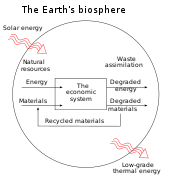
Back اقتصاد الحالة الثابتة Arabic Stationäre Wirtschaft German Economía del estado estacionario Spanish Tasakaalumajandus Estonian Vakaan tilan talous Finnish État stationnaire (économie) French Stato stazionario (economia) Italian 定常経済 Japanese Stationaire economie Dutch Estado estacionário (economia) Portuguese
This article has multiple issues. Please help improve it or discuss these issues on the talk page. (Learn how and when to remove these template messages)
|
| Part of a series on |
| Ecological economics |
|---|
 |
| Part of a series on |
| Anti-consumerism |
|---|
A steady-state economy is an economy made up of a constant stock of physical wealth (capital) and a constant population size. In effect, such an economy does not grow in the course of time.[1]: 366–369 [2]: 545 [3][4] The term usually refers to the national economy of a particular country, but it is also applicable to the economic system of a city, a region, or the entire world. Early in the history of economic thought, classical economist Adam Smith of the 18th century developed the concept of a stationary state of an economy: Smith believed that any national economy in the world would sooner or later settle in a final state of stationarity.[5]: 78
Since the 1970s, the concept of a steady-state economy has been associated mainly with the work of leading ecological economist Herman Daly.[6]: 303 [7]: 32f [8]: 85 As Daly's concept of a steady-state includes the ecological analysis of natural resource flows through the economy, his concept differs from the original classical concept of a stationary state. One other difference is that Daly recommends immediate political action to establish the steady-state economy by imposing permanent government restrictions on all resource use, whereas economists of the classical period believed that the final stationary state of any economy would evolve by itself without any government intervention.[9]: 295f [10]: 55f
Critics of the steady-state economy usually object to it by arguing that resource decoupling, technological development, and the operation of market mechanisms are capable of overcoming resource scarcity, pollution, or population overshoot. Proponents of the steady-state economy, on the other hand, maintain that these objections remain insubstantial and mistaken — and that the need for a steady-state economy is becoming more compelling every day.[11][12][13][8]: 148–155
A steady-state economy is not to be confused with economic stagnation: Whereas a steady-state economy is established as the result of deliberate political action, economic stagnation is the unexpected and unwelcome failure of a growth economy. An ideological contrast to the steady-state economy is formed by the concept of a post-scarcity economy.
- ^ Cite error: The named reference
ngr02was invoked but never defined (see the help page). - ^ Cite error: The named reference
ck01was invoked but never defined (see the help page). - ^ Blauwhof, Frederik Berend (2012). "Overcoming accumulation: Is a capitalist steady-state economy possible?". Ecological Economics. 84: 254–261. Bibcode:2012EcoEc..84..254B. doi:10.1016/j.ecolecon.2012.03.012.
- ^ Lawn, Philip (2011). "Is steady-state capitalism viable?: A review of the issues and an answer in the affirmative". Annals of the New York Academy of Sciences. 1219 (1): 1–25. doi:10.1111/j.1749-6632.2011.05966.x. PMID 21332490. S2CID 40089385.
- ^ Cite error: The named reference
as01was invoked but never defined (see the help page). - ^ Cite error: The named reference
ir01was invoked but never defined (see the help page). - ^ Cite error: The named reference
rs01was invoked but never defined (see the help page). - ^ a b Cite error: The named reference
ap01was invoked but never defined (see the help page). - ^ Cite error: The named reference
mb02was invoked but never defined (see the help page). - ^ Cite error: The named reference
hd04was invoked but never defined (see the help page). - ^ Cite error: The named reference
tj01was invoked but never defined (see the help page). - ^ Cite error: The named reference
bc01was invoked but never defined (see the help page). - ^ Cite error: The named reference
rd01was invoked but never defined (see the help page).
© MMXXIII Rich X Search. We shall prevail. All rights reserved. Rich X Search